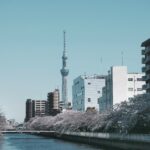Explore the best of Yokohama with this complete Yokohama travel guide—featuring top attractions, must-try food, cultural spots, seasonal events, and easy day trips from Tokyo. Ideal for first-timers and curious explorers.
Table of Contents
Seasonal Clothing in Yokohama

Spring (March–May): Light jackets and thin sweaters
Summer (June–August): Light clothing, short sleeves
Autumn (September–November): Light jackets and coats
Winter (December–February): Coats, wool suits, thick sweaters and jackets
Getting to Yokohama

From Tokyo, you can reach Yokohama Station in about 30 minutes using only regular train lines, no bullet train needed. With frequent departures and various route options, transferring is easy.
From Osaka, take the Shinkansen from Shin-Osaka Station to Shin-Yokohama Station—about 2 hours and 40 minutes.
You can also access Yokohama easily from popular Kanagawa destinations like Kamakura, Shonan, and Hakone using local train lines: about 20–30 minutes from Kamakura and Shonan, and around an hour from Hakone.
Getting from Haneda Airport to Yokohama Station

Let’s go over how to reach Yokohama Station from Haneda Airport, which is the main airport in the Tokyo area with many international flights.
Yokohama Station is the city’s largest transport hub, connected to JR lines, multiple private railways, and the municipal subway—making it the perfect base for exploring the city.
Once you’ve got this route down, you’ll be ready to start your Yokohama adventure stress-free.
Route:
- Take the Keikyu Airport Line from “Haneda Airport Terminal 1 or 2” to “Kamata Station” (~10 min)
- Transfer to the Keikyu Main Line at Kamata Station and ride to “Yokohama Station” (~15 min)
Total time: Around 30 minutes
Public Transport in Yokohama

Yokohama’s public transport is top-notch.
Major tourist attractions are close together, and some can even be reached on foot, so getting around by train and bus is more than enough.
In addition to JR lines, you’ve got private railways like Keikyu and the Minatomirai Line, plus the city subway and lots of bus routes.
No traffic jams, just smooth travels—making public transport the smartest way to explore the city.
Discount Passes for Getting Around Yokohama
Want to save money while sightseeing in Yokohama?
Here are two great ticket options that offer unlimited rides within select areas:
- Yokohama & Minatomirai Pass
This pass offers unlimited rides on the JR Negishi Line (between Yokohama and Shin-Sugita) and the Minatomirai Line.
It’s perfect for visiting top attractions like Chinatown and Yamashita Park.
You can buy it at ticket machines, some vending machines, or online as a digital pass.
Adults: ¥530 / Kids: ¥260 - Yokohama 1-Day Pass
This all-in-one pass gives you unlimited access to Keikyu Line (between Yokohama and Kamiooka), all of the Minatomirai Line, select city and Kanachu buses, and Yokohama Subway.
Pricing depends on your starting station—if you begin at Yokohama Station, it’s ¥1,070 for adults and ¥530 for kids.
There are versions from other stations like Shinagawa or Yokosuka too.
Plus, you’ll get discounts at participating restaurants, shops, and attractions.
8 Must-Visit Tourist Areas in Yokohama
Yokohama is divided into 12 areas, each with its own unique vibe. Out of those, these 8 are especially perfect for travelers. Knowing the character and highlights of each area will help you shape a trip that fits your interests and goals.
1. Minato Mirai 21 Area – Where Landmarks and Modern Charm Collide

Minato Mirai 21 is a newer part of Yokohama, developed on reclaimed land along the city’s eastern edge, just south of Yokohama Station. It’s got clean, organized blocks lined with high-rise buildings and futuristic vibes. At the same time, because it’s by the sea, it has an open, breezy atmosphere. Think cherry blossom trees, parks, and plazas—perfect for a relaxed stroll whether you’re young or old.
There’s a ton to do here:
- Shop inside the retro-style Red Brick Warehouse
- Take in stunning views from the Sky Garden on the 69th floor of Landmark Tower
- Kick back and gaze at the stars in the Konica Minolta Planetarium YOKOHAMA
This is the area with the highest concentration of iconic Yokohama attractions—and it’s just as popular for night views. Definitely a top spot for couples on a date.
2. Kannai & Bashamichi Area – Walk Through Japan’s Westernization Era

Just south of Minato Mirai 21, the Kannai & Bashamichi area is all about nostalgia. Centered around Kannai Station, this district still holds many late 19th to early 20th-century brick buildings.
Here, you’ll find the iconic Three Towers of Yokohama:
- Kanagawa Prefectural Government Building (The King)
- Yokohama Customs House (The Queen)
- Yokohama Port Opening Memorial Hall (The Jack)
Yokohama was Japan’s gateway to the West, and a lot of “firsts” happened here—like the first gas lamps, photo studio, ice cream, newspaper, and telephone.
As evening falls, the gas lamps lining the street come on, and it feels like you’ve time-traveled.
In autumn, Nihon Odori street with its golden ginkgo trees and the historic Yokohama Park are must-stroll spots.
3. Sakuragicho & Noge Area – From Cute Zoos to Pub-Hopping Adventures

Head west of Sakuragicho Station and you’ll find the charmingly local Sakuragicho & Noge area. Unlike the seaside glam of Minato Mirai on the other side of the station, this area has a totally different feel.
Hike up Nogeyama Hill to reach Nogeyama Zoo—a small but lively zoo that’s totally free. Lions, giraffes, red pandas—perfect for a weekend with the kids.
Between Sakuragicho Station and Nogeyama lies Noge’s local pub scene. It’s cozy, down-to-earth, and ideal for hopping between bars. If you like quirky bars and local eats, don’t skip this.
Noge is also known as the “Street Performance Town.” During festival times, you can catch street performers doing everything from juggling to fire shows. Totally worth it if your trip overlaps!
4. Chinatown & Yamashita Park Area – Where Gourmet Meets the Sea Breeze

Just south of Kannai and Bashamichi, around Ishikawacho Station (Motomachi-Chukagai), you’ll step into Yokohama Chinatown—the largest and oldest in Japan. With over 600 restaurants and shops, you can snack your way through Chinese street food or dive into full-on dim sum feasts. It’s heaven for food lovers.
A short walk takes you to Yamashita Park, right by the water. It’s spacious, floral, and perfect for a breezy stroll with ocean views. Come here after lunch and stretch your legs while soaking in the sights.
5. Motomachi & Yamate Area – Vintage Western Elegance in Japan

South of Chinatown, this area around Motomachi Station has serious old-world charm. Back in the 19th century, Yamate was where many foreigners lived after the port opened.
Here you’ll find:
- Seven beautifully preserved Western residences
- The Foreigners’ Cemetery
- Harbor View Park, where you can gaze down at Yokohama’s skyline and bay
Just below the hill, Motomachi Shopping Street offers classy cafes, boutique shops, and the famous Uchiki Bakery—the first bakery in Japan! It’s a great place to wander, shop, and snack in a chic, historic setting.
6. Yokohama Station Area – Big City Vibes & Shopping Galore

Yokohama Station is the main transport hub, served by 4 JR lines, private railways, and the city subway. Around the station, you’ll find totally different vibes depending on the side:
- East Exit: modern high-rises, big shopping malls, and direct airport bus terminals
- West Exit: a maze of smaller shops, eateries, and entertainment joints packed with locals
It’s home to major department stores like Takashimaya, Sogo, and Yokohama MORE’s, where you can explore luxury brands, the latest trends, or pop into the Sogo Art Museum and the interactive Asobuild right by the station.
7. Honmoku, Negishi & Isogo Area – Chill Vibes for Families

South of Motomachi lies a quiet, family-friendly zone that stretches from Negishi Station to Isogo. You’ve got plenty of green space like the old Negishi Racetrack, now converted into a huge park where kids can run around and see real horses.
At Honmoku Pier, there’s a casual fishing park perfect even for beginners—gear rental included.
And don’t miss Sankeien Garden, a breathtaking Japanese garden with historic architecture moved from Kyoto and Kamakura. It’s peaceful, traditional, and bursting with seasonal flowers.
8. Southern Area – Where Adventure and Serenity Coexist

Head even further south to Kanazawa Bunko and Hakkeijima, and you’ll hit Yokohama’s large-scale leisure zone.
Here’s what’s waiting for you:
- Hakkeijima Sea Paradise, a theme park-island with an aquarium, rides, dolphin shows, restaurants, and even hotels.
- Shomyoji Temple, built in the 13th century with a surreal garden that feels like stepping into a different world.
The Southern Area is perfect for families and couples alike. You can easily spend a full day just exploring the island and its attractions.
How Many Days Do You Need to Fully Enjoy Yokohama?
When planning a trip to Yokohama, one big question is how many nights you should stay to really make the most of it. Since many top attractions are concentrated in compact areas, it’s totally doable as a day trip if you stick to the Minato Mirai 21 district and nearby spots. It’s also a great destination to combine with a Tokyo itinerary.
One reason Yokohama is so perfect for day trips is its incredibly easy access from Tokyo.
One-Day Itinerary for Exploring Yokohama’s Top Sights
If you’re hoping to explore Yokohama in just one day, this model course hits all the highlights—amazing views, shopping, local eats, and scenic night views to end the day in style.
9:40
Start from JR Yokohama Station
10:00
Soak up panoramic views at Yokohama Landmark Tower
10:30
Enjoy some retail therapy at Queen’s Square Yokohama
11:20
Hop on the YOKOHAMA AIR CABIN and admire the skyline
11:50
Dive into delicious Chinese cuisine at Yokohama Chinatown
13:50
Stroll and shop along the stylish Motomachi Shopping Street
15:50
Unwind by the water at Yamashita Park
16:50
Pick up souvenirs at the Red Brick Warehouse
18:20
Catch the stunning night view from Bankoku Bridge
If you’re curious about even more model courses or want to explore other parts of Kanagawa beyond Yokohama, check out our in-depth travel guide below.
5 Night View Spots You Should Add to Your Itinerary
The model course includes one classic night view, but if you have time, try visiting these extra dreamy spots. Since the distances between them are short, you can easily fit in a few with a combo of walking and taxis. If you spend a day in Yokohama, this is the perfect romantic wrap-up.
1. Osanbashi Yokohama International Passenger Terminal

A cruise ship terminal where ships from around the world dock. The rooftop has a gently undulating design inspired by ocean waves, and it’s all open-air with uninterrupted views. From here, you get a magical view of Minato Mirai’s skyline, including the Red Brick Warehouse glowing across the water.
2. Harbor View Park (Minato-no-Mieru Oka Koen)

Perched on a small hill, this park offers sweeping views over Yokohama Port. The area was once home to foreign military outposts, and you can still find the French Hill and the British House. At night, you’ll see the Bay Bridge glittering in the distance.
3. Rinko Park

A five-minute walk from Minatomirai Station leads to this spacious green park next to Pacifico Yokohama. The illuminated views of the Landmark Tower, Marine Tower, and Bay Bridge are spectacular. Don’t miss the floating Pukari Pier—especially magical at night.
4. Kishamichi Promenade

A 500-meter path built on old railway tracks that used to run through the port. You’ll walk alongside vintage rails and bridges with city lights reflecting in the water. From here, you can see the giant Cosmo Clock 21 Ferris wheel and the skyline of Minato Mirai—perfect for a romantic evening stroll.
5. Yokohama Red Brick Warehouse

Originally built as high-tech warehouses in the Meiji and Taisho eras, these historic red brick buildings now house shops, restaurants, and cultural spaces. Head to the adjacent Red Brick Park for views of the Bay Bridge and Osanbashi at night—absolutely gorgeous.
3 Must-Try Local Dishes in Yokohama
Yokohama’s culinary scene evolved by blending Western flavors with Japanese traditions after the port opened in the 19th century. Here are three iconic dishes you shouldn’t leave without trying:
1. Sanmamen

A regional noodle dish from Kanagawa, the name comes from Cantonese: “san” (fresh/bean sprouts) and “ma” (add on top). It’s a soy sauce-based soup topped with stir-fried veggies, meat, and mushrooms in a thick, savory sauce that stays hot—ideal for chilly days. Each shop has its own version, and Chinatown classics like Heichinrou or Gyosentei are popular spots to taste it.
2. Gyunabe (Beef Hot Pot)

A forerunner of sukiyaki, this hearty dish features thinly sliced beef simmered with vegetables in a sweet-and-savory miso or soy-based broth. It originated in Yokohama as Japan opened to Western influence, adapting beef to local palates. Unlike sukiyaki, the meat is simmered right from the start. It’s deeply flavorful and perfect with rice.
3. Iekei Ramen (Yokohama-Style Ramen)

Iekei ramen is rich, hearty, and totally satisfying, with a thick pork-and-soy broth and chewy noodles. Originating from the shop “Yoshimura-ya” in Yokohama, it became a nationwide phenomenon. Toppings usually include roast pork, spinach, seaweed, and scallions. There’s nothing quite like slurping down a bowl where it all began.
Must-Visit Cherry Blossom Spots for a Spring Trip to Yokohama

If you’re visiting Yokohama in spring, be sure to add some cherry blossom viewing to your itinerary. One of the most beloved spots is Sankeien Garden, where historic buildings relocated from Kyoto and Kamakura are surrounded by blooming sakura, offering a scene full of Japanese charm.
Also highly recommended are:
- Mitsuike Park: With around 1,600 cherry trees and three ponds, the scenery is breathtaking, especially when reflected on the water’s surface.
- Negishi Forest Park: This spacious meadow is home to around 350 cherry trees, blooming in soft pink like a cloudscape floating over the fields.
Here’s a general idea of when the cherry blossoms are at their best in Yokohama:
- Start of blooming: March 25
- Full bloom: April 1
- Best viewing period: April 1–7
(Note: Dates may vary depending on the year’s weather and the specific spot, so it’s a good idea to check forecasts before your trip.)
Stunning Autumn Leaves in Yokohama

Planning a trip to Yokohama in the fall? Don’t miss out on the city’s best foliage spots. Just like in spring, Sankeien Garden shines again in autumn. The vibrant leaves contrast beautifully with its historic buildings, transporting visitors to old Kyoto or Kamakura.
Other top spots include:
- Higa Garden (Higateien): A small but elegant Japanese garden inside Yokohama Park, where maples and ginkgo trees blaze in reds and golds.
- Negishi Forest Park: The gentle slopes and surrounding woods turn into a vivid gradient of fall colors. It’s a relaxing place to stroll and take it all in.
Yokohama’s autumn foliage typically peaks from late October to early December, but as always, the exact timing depends on the weather. Be sure to check current foliage reports before heading out.
- What to Do in Yokohama with kids: 20+ Must-See Spots & Experiences (2025)

- 10 Best Tokyo Tours You Absolutely Can’t Miss in 2025 (From Foodie Walks to Cultural Adventures)

- 10 Best Tokyo Art Museums You Can’t Miss in 2025 (Modern, Traditional & Hidden Gems)

- 5 Most Beautiful Ryokan In Japan: Unwind in Timeless Tranquility [2025 Updated]
![5 Most Beautiful Ryokan In Japan: Unwind in Timeless Tranquility [2025 Updated] 4 Most Beautiful Ryokan In Japan](https://tokyocandies.com/wp-content/uploads/2023/07/247309602-150x150.jpg)
- 16 Most Romantic Hotels In Tokyo: Dreamy Stays for Couples [2025 Updated]
![16 Most Romantic Hotels In Tokyo: Dreamy Stays for Couples [2025 Updated] 5 Most Romantic Hotels In Tokyo](https://tokyocandies.com/wp-content/uploads/2023/07/thula-na-p59ux9myc74-unsplash-150x150.jpg)
